In our previous sessions We had worked on coordination for pivoting with a view to developing awareness and skills but although skills were improving the uncomfortable stance and the glitch were still there. I just asked Rowdy to ski a few turns while I watched and could see immediately that the overall timing was still wrong and the stance was wrong – in the same way as previously described in Rowdy-2. Chi Skiing – Hip position My intuition was screaming at me that the entire problem was the hip joint. I could see how the hip was still swinging out at the start of the turn and this was forcing Rowdy to come up at the start of the turn instead of move down. For this reason I decided to bring the focus entirely onto the hip joints and their immediate function. The first thing I asked Rowdy to so was to pull the hip joint back further and stronger but also to do this right at the start of the turn – switching hips during the turn transition. Rowdy has not been trying to do this. He had been trying to pull the hip back progressively during the turn. Attempting to make this move generated a lot of confusion because his body was imposing the opposite movement pattern on him unconsciously. (Video clip where the glitch is almost gone – until when the turns are completed more – but much better and more relaxed looking stance in general)
Skating To lift the confusion I asked Rowdy to skate and then introduce dynamics. This “direct method” of bringing skating into skiing generally sorts out timing issues. The down/up skating action fits the down/up dynamics action (motorbike going down into a turn and coming back up out of it). Once the skating is working and the dynamics then all that has to be added is the pull back of the hip on the skating leg and then all of the components are in place. This did succeed in removing the confusion. Flow and Non – Resistance Once the skating was in place we moved onto the next stage which is about how hip angulation is actually applied. Most people “brace” against the forces in a turn and tighten the muscles around the hip joints. The opposite is required with selective relaxation of the hips – allowing the body to literally drop down into the turn at the hip joint with the hip becoming very loose. The aim is to let the centre of mass drop quickly and by altering the body shape to place the skis more on edge. This loads up the carving ski with great force and if the timing is sensitive it sets up a resonance – like on a trampoline – which the skier can respond to (or dampen instead). The ski loading up with pressure rapidly then turns quickly and lifts the skier back up out of the turn for the next cycle. The key to this is to have complete relaxation at the hip joint and to be aware of using the centre of mass for generating pressure.
In chi-running speed is increased through relaxing at the hips – and allowing gravity to topple you forwards more, not through greater strength and power. Likewise the more dynamic and short carved turns are achieved through greater relaxation not through greater strength. The Energy Illusion article linked to here explains how flow is achieved through improved organisation. Although we started with carving to have clear feedback I explained that the same basic movements were required all the time when skiing. Rowdy’s main focus for the time being is to pull the hip back more strongly and to feel this in the body.  In this photo Rowdy is on his weaker left leg and there is still no hip angulation visible – with the shoulder tending to be puled back along with the hip. Things were well enough in place though to avoid a glitch.
In this photo Rowdy is on his weaker left leg and there is still no hip angulation visible – with the shoulder tending to be puled back along with the hip. Things were well enough in place though to avoid a glitch.  In this photo everything is basically in the right place, right hip pulled back, spine twisted (Upper/Lower body separation at the rib cage) and hip angulation obvious. The right knee could be held in more strongly with the adductors – but this can also be a function of the overall motion of the centre of mass. Some very strong skiers demonstrating hip angulation…
In this photo everything is basically in the right place, right hip pulled back, spine twisted (Upper/Lower body separation at the rib cage) and hip angulation obvious. The right knee could be held in more strongly with the adductors – but this can also be a function of the overall motion of the centre of mass. Some very strong skiers demonstrating hip angulation… 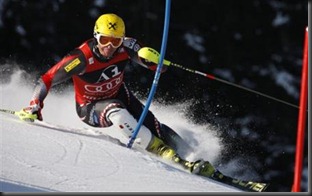
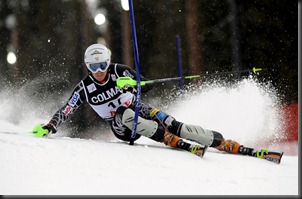
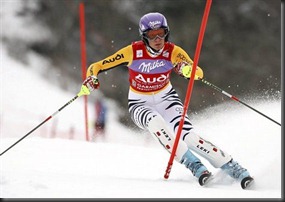
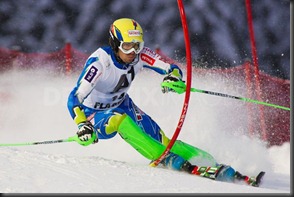
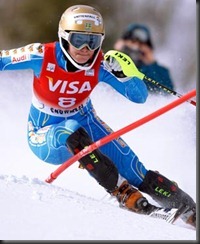
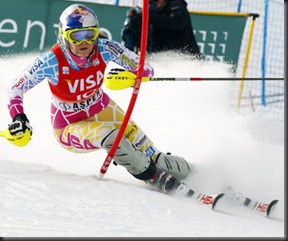
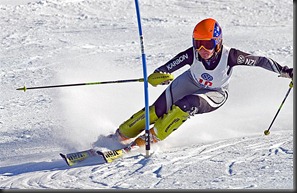
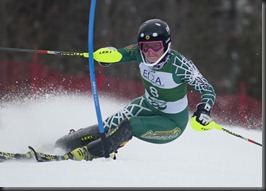 Centre of Mass and Centre of Power I explained to Rowdy that all motion must start from the centre. The centre of mass (CM) is normally right in front of the base of the spine. You think first of all about where you are going to direct your CM and then organise all of your movement around this point, pulling back the hip to twist the spine at the ribs – pulling the pelvis up into neutral and stretching the lower abdomen. At the same time the support foot is pushed ahead and this liberates the body to completely realign to the inside of the new turning ski – without having to pop up or delay the CM from moving inwards and down into the next turn. The spine is the centre of power (CP) and this should be activated instead of the hip locking and everything above it going loose and relaxed as commonly happens when the hip is permitted to rotate forwards instead of being pulled back. The CM and CP are not the same thing but they are normally very close together and so activity should radiate outwards from there. This can proceed as a check list right down to the feet: Move CM in and down, pull hip back (feel separation at ribs – twist in spine), pelvic tilt (neutral), adductor pulling inwards, subtaler joint rolled inwards (below ankle), pressure on point just in front of heel.
Centre of Mass and Centre of Power I explained to Rowdy that all motion must start from the centre. The centre of mass (CM) is normally right in front of the base of the spine. You think first of all about where you are going to direct your CM and then organise all of your movement around this point, pulling back the hip to twist the spine at the ribs – pulling the pelvis up into neutral and stretching the lower abdomen. At the same time the support foot is pushed ahead and this liberates the body to completely realign to the inside of the new turning ski – without having to pop up or delay the CM from moving inwards and down into the next turn. The spine is the centre of power (CP) and this should be activated instead of the hip locking and everything above it going loose and relaxed as commonly happens when the hip is permitted to rotate forwards instead of being pulled back. The CM and CP are not the same thing but they are normally very close together and so activity should radiate outwards from there. This can proceed as a check list right down to the feet: Move CM in and down, pull hip back (feel separation at ribs – twist in spine), pelvic tilt (neutral), adductor pulling inwards, subtaler joint rolled inwards (below ankle), pressure on point just in front of heel.

